|
|
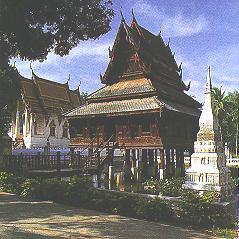 Ho Trai in the middle of a waterway. On the left is Ho Phra Buddha Bat |
 Wat Thung Sri Muang |
|
- Built by Venerable Chao Khun Phra Ariyawongsachan around 1829, in
the reign of King Rama III, Wat Thung Sri Muang is an old temple situated in the heart of Ubon Ratchathani Province.
- Venerable Chao Khun Phra Ariyawongsachan originally resided at Wat Srageath in Bangkok. He traveled to Ubon Ratchathani Province and stayed at Wat Pa Kaeo Mani Wan (presently Wat Mani Wanaram). Every morning and evening, Venerable Chao Khun Phra Ariyawongsachan left the temple to meditate at the Dong U Phung Forest, the present location of Wat Thung Sri Muang. Realizing that this peaceful area was suitable for serving as a religious center, he brought a replica of the Holy Footprint from Wat Srageath to which the Ubon Ratchathani residents could pay homage, and a hall was constructed to house the replica. The hall was transformed into the Ubosot (main chapel) in 1829 by Ykhuchang, a monk from Vientiane who was expert in construction work. The art form of the Ubosot is, therefore, a mixture of the early Rattanakosin and Lan Chang styles. The lower structure of the Ubosot is in the northeastern style and the roof is of the Rattanakosin art form. Inside the Ubosot are the old presiding Buddha image in the posture of Subduring Mara (measuring 2.39 meters at the lap), the replica of the Holy Footprint, and fine murals on the four walls. These murals depict the Lord Buddha's former life, as well as the livelihood and costumes of northeastern residents in those days.
- One of the well-known religious structures at Wat Thung Sri Muang is Ho Phra Traipidok (Tripitaka), the hall for storing the Holy Scriptures. At Wat Thung Sri Muang, Ho Phra Traipidok is generally referred to as Ho Trai Klang Nam because it is located in the middle of a pond. It is a mixture of three types of craft, namely Thai, Burmese and Lao. The building is of the central Thailand architectural style while the roof is a mixture of Thai and Burmese art forms. This structure is made of hard wood, and its gables are engraved with intricate designs on both sides. This is in the Lao classical art style, and is regarded as the most beautiful of its kind in northeastern Thailand. The hall is the place where Tripitaka, the Holy Scriptures, are kept so they can be saved from destruction caused by insects. Such a hall is usually built in the middle of a pond or other safe area.
- Ho Phra Traipidok, or Ho Trai for short, was built after the Ho Phra Buddha Bat or Ho Phra Bat for short, The pond was dug to bring soil to heighten the base of Ho Phra Buddha Bat. When the construction of Ho Trai was completed, the pond was named Sa Ho Trai. Ubon Ratchathani Provincial Administration and Wat Thung Sri Muang plan to grow lotus of diverse colors in the pond to decorate the Ho Trai in honor of this place of Holy Scriptures. The pond will then be called "Sa Bok Khorani Sri Muang" as originally planned.
- Ho Trai is often built in large temples, which serve as Buddhist centers in each area. Apart from Wat Thung Sri Muang, such a hall is also found at Wat Si Pho Chai in Trakan Phutphon District. The Ho Trai in this district was built in the middle of a waterway at Nong Khu Lu. Another Ho Trai had been found at Wat Ho Trai in Khuang Nai District but it was later demolished. The Ho Trai in the middle of the pond at Wat Mahathat in Yasothon Province resembles that of Wat Thung Sri Muang. It is believed that the same craftsman constructed both of them.
- Ho Phra Bat has fine Chofa (horn-like finial on the roof ridge), Bai Raka (a horn-like ridge on the sloping edges of a gable), Kan Thuai (eaves brackets) and (Hang Hong (small finials jutting out of the two corners of the gable) similar to those of a temple. It is in the Vientiane architectural style.
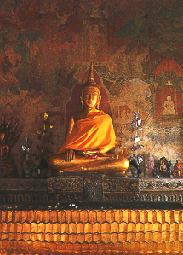
The presiding Buddha image and the replica of the Holy Footprint inside Ho Phra Buddha Bat- The Si Muang Viharn (secondary chapel) is another important structure of Wat Thung Sri Muang. It houses Phra Chao Yai Si Muang, an old presiding Buddha image built at the same time as Ubon Ratchathani in 1792. Originally enshrined at Wat Nua Tha, which is among the first temples in Ubon Ratchathani, Phra Chao Yai was cast during the reign of Phra Pra Thum Worarat Suriyawong (Kham Phong), the first governor of Ubon Ratchathani. It is older than the presiding Buddha image known as Phra Chao Yai in Plang. //later, when Wat Nua Tha was demolished in 1925, this Buddha image was enshrined at Wat Thung Sri Muang where it remains.
- The Three structures, Ho Phr Buddha Bat (which is more than 100 years old), Ho Phra Traipidok (which is recognized as the most beautiful one in the Northeast), and Si Muang Viharn (which houses the revered Phra Chao Yai Si Muang) are important holy places of Wat Thung Sri Muang. Ho Trai and Ho Phra Bat are the revered religious structures of Ubon Ratchathani. They are of historical significance and represent the unique art and culture of Ubon Ratchathani.
- All three religious structures make a name for Ubon Ratchathani Province. The three structures are worth visiting for both Buddhists and tourists who appreciate Thai art and culture.
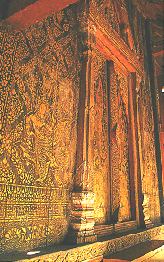
A lacquered and gilded painting depicting Kinnaree ( mythical being) inside Ho Trai
'Fa Pa Kon' in the Thai architectural style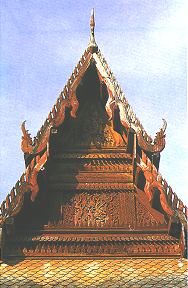
Ho Trai's gables beautifully engraved in the Lao art form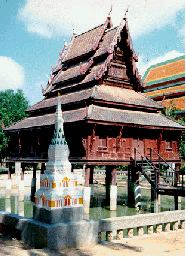
Wat Thung Sri MuangRelevant Definitions - Ho (hall) is a structure in the Buddhist temple built for several purposes, such as to keep Holy Scriptures, or serve as prayer room, monks dining room or belfry.
- Tripitaka, the Holy Scriptures, consist of the teachings of Buddha, which are divided into three parts.
- Sim, typical small size ubosot (main chapel) of Thailand's northeastern region.
- Venerable Chao Khun Phra Ariyawongsachan originally resided at Wat Srageath in Bangkok. He traveled to Ubon Ratchathani Province and stayed at Wat Pa Kaeo Mani Wan (presently Wat Mani Wanaram). Every morning and evening, Venerable Chao Khun Phra Ariyawongsachan left the temple to meditate at the Dong U Phung Forest, the present location of Wat Thung Sri Muang. Realizing that this peaceful area was suitable for serving as a religious center, he brought a replica of the Holy Footprint from Wat Srageath to which the Ubon Ratchathani residents could pay homage, and a hall was constructed to house the replica. The hall was transformed into the Ubosot (main chapel) in 1829 by Ykhuchang, a monk from Vientiane who was expert in construction work. The art form of the Ubosot is, therefore, a mixture of the early Rattanakosin and Lan Chang styles. The lower structure of the Ubosot is in the northeastern style and the roof is of the Rattanakosin art form. Inside the Ubosot are the old presiding Buddha image in the posture of Subduring Mara (measuring 2.39 meters at the lap), the replica of the Holy Footprint, and fine murals on the four walls. These murals depict the Lord Buddha's former life, as well as the livelihood and costumes of northeastern residents in those days.
 Wat Thung Sri Muang: the major chapel, 200 years old, was constructed during the early Chakri dynasty. Interior walls were
beautifully painted, showing the culture and history of the ancient Ubon people. Some paintings, are somewhat erotic. Ho Trai, a scriptural
repository made of teak, built in the middle of the pond, contains holy Buddhist books, inlaid with gold leaves.
Wat Thung Sri Muang: the major chapel, 200 years old, was constructed during the early Chakri dynasty. Interior walls were
beautifully painted, showing the culture and history of the ancient Ubon people. Some paintings, are somewhat erotic. Ho Trai, a scriptural
repository made of teak, built in the middle of the pond, contains holy Buddhist books, inlaid with gold leaves.